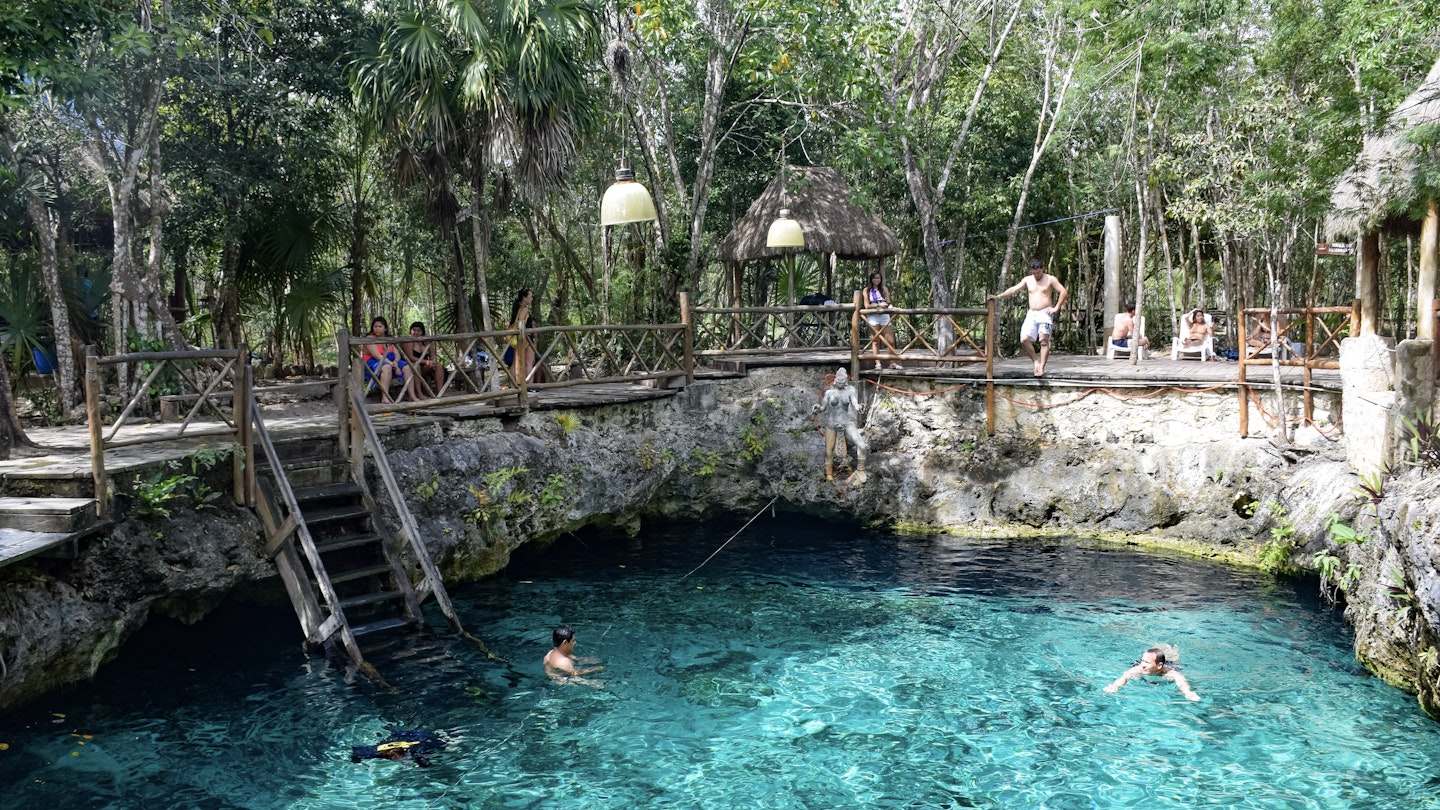Mexico’s Yucatán Peninsula boasts stunning beaches around Cancún, Playa Del Carmen, and Tulum. However, for those looking to cool off from the sun, the cenotes offer a magical underworld of turquoise pools where ancient Mayans once communicated with their gods.
Cenotes are natural swimming holes that emerge from the collapse of porous limestone bedrock, revealing clear groundwater pools. The Mayans revered these cenotes as sacred wells, essential for water during dry times. Swimming in these pristine waters feels like stepping into a different time, where giant tropical trees create cathedral-like walls and shafts of sunlight illuminate the landscape.
Most cave cenotes feature fresh water, meticulously filtered by the earth, providing exceptional clarity and a vibrant underwater world to explore. Open-air cenotes are equally impressive, often enriched with nutrient-rich algae that benefit your skin while you swim.
Cenote Yokdzonot, near Chichén Itzá
Located just beyond the more famous cenote a short drive from the Mayan pyramids, Cenote Yokdzonot offers a tranquil experience. Visitors can enjoy a refreshing swim in clear waters, occasionally sharing the space with small fish and birds fluttering above.
Admire the dedication of local Mayan women who maintain this ecological treasure. The surrounding trails and stone pathways showcase their handcrafted craftsmanship.

Cenote Dos Ojos, near Tulum
Cenote Dos Ojos, meaning “two eyes”, features two distinct pools: one is bright blue and clear, while the other embodies a darker, cavernous underwater world. The snorkeling opportunities in the darker cenote are remarkable, revealing stunning stalactites and otherworldly formations.
In addition to snorkeling, visitors can walk through dry caves that harbor roosting bats and other intriguing flora. Renting a car or joining a tour is advisable for access to this enchanting site.

Cenote Azul, near Tulum and Playa Del Carmen
Cenote Azul offers a charming local atmosphere with clean, turquoise water that allows for clear views of darting tropical fish beneath the surface. Families can enjoy diving off rocks, while others can relax in the shallow pools or explore meandering pathways in the area.
Local minivans serve as affordable transport options from Playa Del Carmen or Tulum, making access easy for travelers.

Cenote Samulá, near Valladolid and Chichén Itzá
Cenote Samulá in Dzitnup is a stunning location, featuring pulsating colored lights that create an enchanting ambiance. Sunlight streams through the ceiling, casting captivating reflections on the water.
Visitors can appreciate the unique atmosphere, decorated with tree roots and wildlife, making the experience truly memorable.
Cenote Ponderosa, near Playa Del Carmen
Embracing mystery, Cenote Ponderosa (or Jardín del Edén) has a historical significance tied to Mayan rituals. With depths reaching 15m (49 ft), divers can explore its depths or simply enjoy the surface while seeking shimmering fish and underwater caves.
The cenote is nestled within a humid valley, creating a serene setting that mirrors the beauty and spirituality of ancient Mayan culture.

Grutas de Loltún, near Chichén Itzá and Tulúm
For those who prefer to stay dry, Grutas de Loltún showcases the stunning beauty of cenotes without the need for swimming. These caves, the largest in the Yucatán Peninsula, offer a remarkable journey through nature’s creations.
Guided tours reveal ancient drawings, as well as impressive stalagmites and stalactites, providing an insightful glimpse into the area’s rich history.

What to bring for a Yucatán cenote adventure
When visiting cenotes, it’s essential to bring swimwear, water, sandals or flip-flops, and a towel. Leave valuables at home and remember to pack reef-safe sunscreen to protect the delicate ecosystem. Entrance fees are around 200 pesos (USD $10) per person.
Most cenotes offer changing facilities and rentals for flashlights, life vests, and snorkeling gear. It’s common to find nearby taxis and snacks, ensuring a comfortable experience during your visit.
Article last updated in December 2020.





